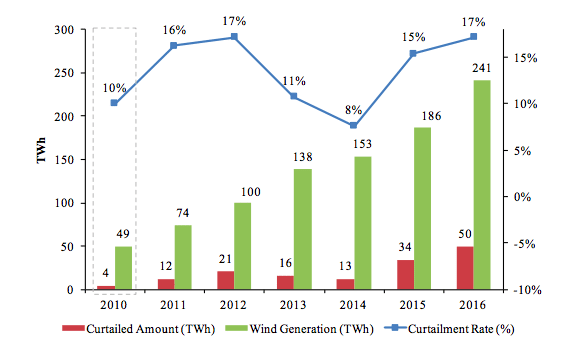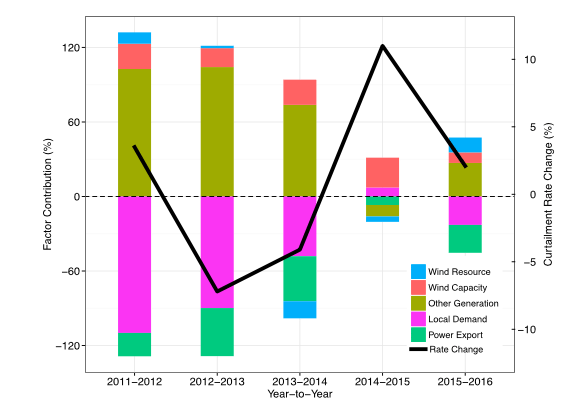
China’s energy transition from a system dominated by coal to one of the world’s largest deployments of wind power is facing major challenges after China has entered the economic “New Normal” in recent years.
A key phenomenon is serious wind curtailment, where potential clean wind power is abandoned and the associated environmental and climate benefits could not be fulfilled.

Figure 1: Two waves of wind curtailment in China (2010-2016) Republished with permission from Elsevier
China, despite having nearly twice as much wind capacity installed, generated less electricity from wind power than the US in 2015. In 2016, China has curtailed 50 TWh of wind power, more than half of the annual electricity generation by the Three Georges Dam. The national average curtailment rate (curtailment amount / (curtailment amount + actual generation)) amounts to 17%, and in certain provinces, this number exceeds 40%. By contrast, Denmark, the country with the world-highest wind penetration rate, saw essentially zero wind curtailment.
Multiple explanations have been proposed to help understand the serious wind curtailment in China, including: (i) an inflexible electricity grid to handle intermittent wind power output; (ii) grid operation and pricing norms favoring coal; (iii) lack of transmission capacity to transport wind power generation to electricity demand centers; (iv) excessively installed capacity of electricity generation including wind; and (v) slowing down in growth of electricity demand. However, few studies paid attention to the two different waves of wind curtailment and quantify the relative contributions of the underlying factors.
In a recent Applied Energy article, Researchers from Renmin University of China and Tsinghua University developed a flexible five-factor framework and employed quantitative methods to disentangle contributions of various factors to wind curtailment in China. Those five factors are derived directly from the definition of wind curtailment rate: local electricity demand in a province, power export to other provinces, other power generations than wind, wind installed capacity and finally wind resources in a province and year.
Results show that while the early stage of wind curtailment was first constrained (2011-2012) and then relieved (2013-2014) by transmission capacity, recent wind curtailment (2015-2016) is primarily driven by the economic “new normal”, which resulted in a slowdown of electricity demand and low willingness-to-accept imported power across provinces. In certain wind-rich provinces such as Gansu and Jilin, electricity demand growth even became negative in 2015. In other words, even if power exporting stayed the same as in 2014, all existing electricity generation capacity will face curtailment issue, not to mention newly-installed wind and other capacities in 2015.

Figure 2: Wind curtailment rate decomposed into contributions from five factors (2011-2016) Republished with permission from Elsevier
In Figure 2 above, the contribution of local (electricity) demand first reduces wind curtailment rate; however, its contribution decreased over time and in 2015, the contribution even became increasing wind curtailment rate. Similar patterns could also be seen in power export, reflecting poor demand in other provinces. Coal and other generations generally increased wind curtailment rate, except in 2015 that owing to the demand-side reason, these generations have to be utilized less as well. Another interesting observation in Figure 2 is that wind capacity addition did not respond to the wind curtailment problem actively, reflecting a potential misaligned incentive issue there.
Overall, we have identified two waves of serious wind curtailment since 2010. While the first wave was mainly due to rapid wind capacity development without sufficient transmission capacity, the second wave of wind curtailment starting from 2015 pointed to slowed electricity demand growth as the major driving factor. To increase the utilization of wind power, one has to either reduce the utilization of other energy or simply bring about more demand, or both. Considering the requirements of the New Normal and the pressure to tackle climate change, a better solution for China would be to increase substitution of wind for coal.
These findings are described in the article entitled Decomposing driving factors for wind curtailment under economic new normal in China, recently published in the journal Applied Energy. This work was conducted by Changgui Dong from the Renmin University of China, and Ye Qi, Wenjuan Dong, Xi Lu, Tainle Liu, and Shuai Qian from Tsinghua University.









